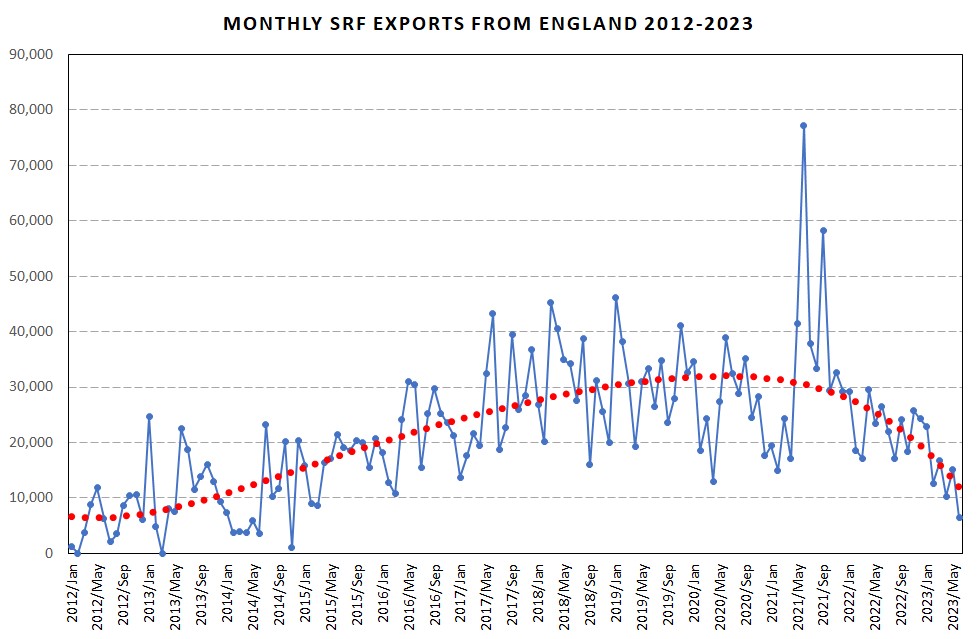Emissions Trading Scheme – There May Be Trouble Ahead
Disjointed policy implementation can harm both the environment and commerce. With the UK and the EU both looking to apply Emissions Trading Scheme (UK ETS) tariffs to the Energy from Waste sector by the end of the decade, will there be mutual dialogue and coordination, or will it follow the same fractious path as the planned Deposit Recovery Scheme in the UK?
RDF and SRF Export Summary
Exports of Secondary Recovered Fuels (SRF) continue to decline, with operations beyond North West Europe markedly sluggish. This paints a contrasting picture when compared with Refused-Derived Fuel (RDF) exports; despite a comparatively low figure in June, the overall trajectory for RDF exports presents a considerably more optimistic view.


Over 80% of RDF exports are dispatched to Sweden, the Netherlands, and Germany. All three destination countries exhibit double-digit percentage growth on a year-to-year basis. However, there are underlying indications of potential volatility in the growth trajectory of the Netherlands that warrant attention. Traditionally, SRF has had a wider geographic reach than RDF, extending to Eastern or Southern Europe, or even to more distant locations such as India, Morocco, Senegal, and the United States.
In a buoyant economic market, construction projects flourish, leading to increased demand for SRF at cement plants. Conversely, in the current context of economic stagnation, demand plummets. The added burden of elevated shipping costs for SRF to distant destinations, particularly given the soaring price of fuel, exacerbates the situation. Operators capable of flexibly transitioning between RDF and SRF production demonstrate greater resilience in such fluctuating environments.
The demand from Germany for English RDF is on a particularly sharp incline, backed by robust momentum. Several companies, including Andusia, Suez, and Veolia, seem to be enjoying a favourable wind at present, with year-on-year growth buttressed by encouraging quarter-on-quarter perspectives.
Emissions Trading Scheme On The Horizon
Recently, the UK Government declared that Energy from Waste (EfW) and incineration plants would be incorporated into the UK Emissions Trading Scheme (ETS) from 2028. This decision effectively imposes a tax on EfW operators. Such a burden is likely to be partially or wholly transferred to feedstock suppliers via an increase in gate fees. Unless the implementation of this levy coincides with the EU’s equivalent ETS, an uneven burden will arise, with one side benefitting at the expense of the other. The latest stance from the EU indicates that EfW installations will be included from 2028, offering a potential opt-out until 2030.
It would be reasonable to expect that the two emissions schemes would work closely together. However, one might have also anticipated a smooth implementation of the planned Deposit Return Schemes (‘DRS’) in the UK. Unfortunately, this has not been the case, resulting in the collapse of the planned launch in Scotland, the liquidation of the appointed scheme administrator and Biffa set to be significantly out of pocket.
This DRS debacle underlines the fact that different jurisdictions ultimately operate at their own pace. And while 2028 may still be a few years away, it is close enough to factor into feedstock contract negotiations or renewals. As far as RDF production is concerned, waste companies and fuel producers are advised to explore methods of removing and recovering as much plastic as possible, as the ‘fossil carbon’ component will trigger the majority of the levy.
The unilateral implementation of the €32-per-tonne waste import levy in the Netherlands at the start of 2020 triggered a 50% decrease in RDF shipments to the country. There is evidence suggesting this led to an increase in landfill deposits of RDF and other residual waste. The lesson learned is that disjointed application of levies can cause environmental as well as commercial damage, counteracting the intended objectives of discouraging fossil carbon emissions into the atmosphere.
